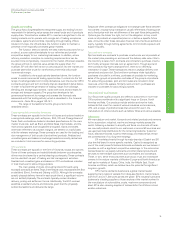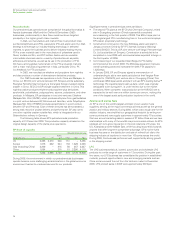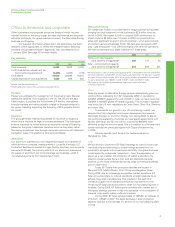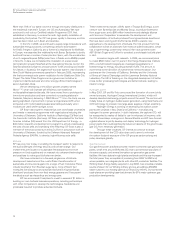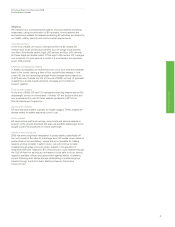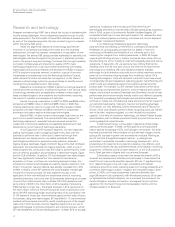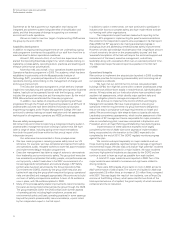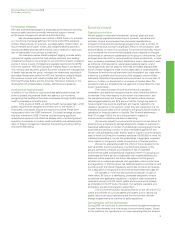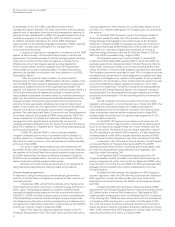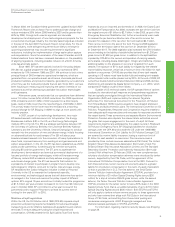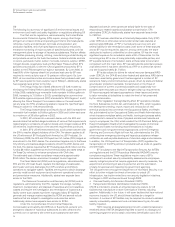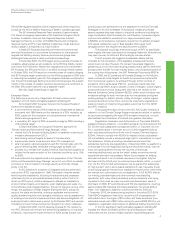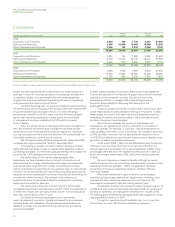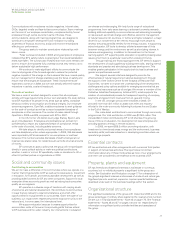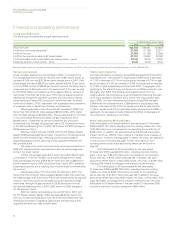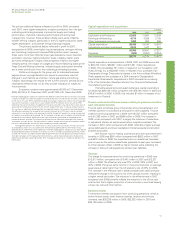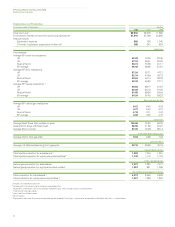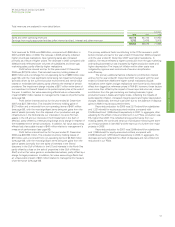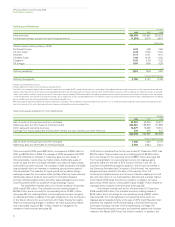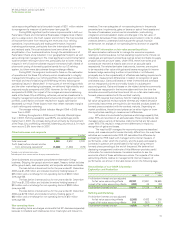BP 2008 Annual Report Download - page 46
Download and view the complete annual report
Please find page 46 of the 2008 BP annual report below. You can navigate through the pages in the report by either clicking on the pages listed below, or by using the keyword search tool below to find specific information within the annual report.
BP Annual Report and Accounts 2008
Performance review
In March 2008, the Canadian federal government updated its April 2007
Framework Report with an Action Plan to address climate change and
reduce emissions 20% below 2006 levels by 2020 and by greater than
60% by 2050, through both a sector approach and domestic
development and deployment of new technologies and projects. For the
conventional oil and gas industry, the intensity based targets as included
in the plan of the April 2007 Framework Report remain likely. For the oil
sands industry, more stringent requirements are likely to emerge for
upcoming projects that may include requirements for significant
reductions, including the implementation of large scale carbon capture
and sequestration. Since the conclusion of the recent Canadian and US
Federal elections there has been increased discussion on the possibility
of aligning regulations, including possible inclusion of a North America
wide cap-and-trade system.
Since 1997, BP has been actively involved in the policy debate.
We also ran a global programme that reduced our operational GHG
emissions by 10% between 1998 and 2001. We continue to look at two
principal kinds of GHG emissions: operational emissions, which are
generated from our operations such as refineries, chemicals plants and
production facilities; and product emissions, generated by our customers
when they use the fuels and products that we sell. Since 2001, we have
been focusing on measuring and improving the carbon intensity of our
operations as well as developing sustainable low-carbon technologies
and businesses.
After seven years, we estimate that our operations have delivered
some 7.5 million tonnes (Mte) of GHG reductions. Our 2008 operational
GHG emissions were 61.4Mte of CO2 equivalent on a direct equity
basis, nearly 2.1Mte lower than the reported figure of 63.5Mte in 2007.
The primary reason for the lower reported emissions is a reporting
protocol change for BP Shipping (1.9Mte) to align us more closely with
industry practice.
In 2007, as part of our technology development, two major
BP-backed research institutes came into full operation: the Energy
Biosciences Institute (EBI) in the US, and the Energy Technologies
Institute (ETI) in the UK. The EBI is a strategic partnership between BP,
the University of California, Berkeley, the Lawrence Berkeley National
Laboratory and the University of Illinois, Urbana-Champaign to conduct
research into the production of new and cleaner energy, initially focusing
on advanced biofuels for road transport. The EBI will also pursue
bioscience-based research into the conversion of heavy hydrocarbons to
clean fuels, improved recovery from existing oil and gas reservoirs and
carbon sequestration. In the UK, the ETI has been established as a 50:50
public private partnership, funded equally by member companies,
including BP, and the government. The ETI aims to accelerate the
development, demonstration and eventual commercial deployment of a
focused portfolio of energy technologies, which will increase energy
efficiency, reduce GHG emissions and help achieve energy security
and climate change goals. The ETI has issued its first invitation for
expressions of interest to participate in programmes to develop new
technologies for offshore wind and for marine, tidal and wave energy.
BP established the Carbon Mitigation Initiative in 2000 at Princeton
University in the US to research the fundamental scientific,
environmental, and technological issues that will determine how carbon
is managed in the future and examine the policy impact of different
options. BP’s original 10-year commitment initially funded the programme
at $1.5 million per year and later increased it to more than $2 million per
year. In October 2008, BP committed to a five-year renewal of the
partnership and to support Princeton to at least its current level of
funding for the years 2011 to 2015.
Maritime oil spill regulations
Within the US, the Oil Pollution Act of 1990 (OPA 90) imposes oil spill
prevention and planning requirements liability for tankers and barges
transporting oil and for offshore facilities such as platforms and onshore
terminals. To ensure adequate funding for oil spill response and
compensation, OPA 90 created the Oil Spill Liability Trust Fund that is
financed by a tax on imported and domestic oil. In 2006, the Coast Guard
and Maritime Transportation Act 2006, increased the size of the fund from
the original amount of $1 billion to $2.7 billion. In late 2008, as part of the
Emergency Economic Stabilization Act, further amendments were made
to increase the per-barrel contribution rate of tax and to remove the
provision for cessation of the tax when the fund reached $2.7 billion.
There is now no limit on the size of the fund. The same 2008 legislation
amended the termination date of this tax from 31 December 2014 to
31 December 2017. The 2006 legislation also increased the OPA limitation
amount relating to the liability of double-hulled tankers from $1,200 per
gross tonne to $1,900 per gross tonne. In addition to the spill liabilities
imposed by OPA 90 on the owners and operators of carrying vessels,
some states, including Alaska, Washington, Oregon and California, impose
additional liability on the shippers or owners of oil spilled from such
vessels. The exposure of BP to such liability is mitigated by the vessels’
marine liability insurance, which has a maximum limit of $1 billion for each
accident or occurrence. OPA 90 also provides that all new tank vessels
operating in US waters must have double hulls and existing tank vessels
without double hulls must be phased out by 2015. At the end of 2008, BP
owned four double-hulled tankers built between 2004 and 2006, demise-
chartered to and operated by Alaska Tanker Company, L.L.C. (ATC), which
transports BP Alaskan crude oil from Valdez.
Outside of US territorial waters, the BP-operated fleet of tankers
is subject to international spill response and preparedness regulations
that are typically promulgated through the International Maritime
Organization (IMO) and implemented by the relevant flag state
authorities. The International Convention for the Prevention of Pollution
from Ships (Marpol 73/78) requires vessels to have detailed shipboard
emergency and spill prevention plans. The International Convention on Oil
Pollution, Preparedness, Response and Co-operation requires vessels to
have adequate spill response plans and resources for response anywhere
the vessel travels. These conventions and separate Marine Environmental
Protection Circulars also stipulate the relevant state authorities around
the globe that require engagement in the event of a spill. All these
requirements together are addressed by the vessel owners in Shipboard
Oil Pollution Emergency Plans. BP Shipping’s liabilities for oil pollution
damage under the OPA 90 and outside the US under the 1969/1992
International Convention on Civil Liability for Oil Pollution Damage (CLC)
are covered by marine liability insurance, having a maximum limit of
$1 billion for each accident or occurrence. This insurance cover is
provided by three mutual insurance associations (P&I Clubs): The United
Kingdom Steam Ship Assurance Association (Bermuda) Limited; The
Britannia Steam Ship Insurance Association Limited; and The Standard
Steamship Owners’ Protection and Indemnity Association (Bermuda)
Limited. With effect from 20 February 2006, two new complementary
voluntary oil pollution compensation schemes were introduced by tanker
owners, supported by their P&I Clubs, with the agreement of the
International Oil Pollution Compensation Fund at the IMO. Pursuant to
both these schemes, tanker owners will voluntarily assume a greater
liability for oil pollution compensation in the event of a spill of persistent
oil than is provided for in CLC. The first scheme, the Small Tanker
Owners’ Pollution Indemnification Agreement (STOPIA), provides for a
minimum liability of 20 million Special Drawing Rights (around $30
million) for a ship at or below 29,548 gross tonnes, while the second
scheme, the Tanker Owners’ Pollution Indemnification Agreement
(TOPIA), provides for the tanker owner to take a 50% stake in the 2003
Supplementary Fund, that is, an additional liability of up to 273.5 million
Special Drawing Rights (around $405 million). Both STOPIA and TOPIA
will only apply to tankers whose owners are party to these agreements
and who have entered their ships with P&I Clubs in the International
Group of P&I Clubs, so benefiting from those clubs’ pooling and
reinsurance arrangements. All BP Shipping’s managed and time-
chartered vessels participate in STOPIA and TOPIA.
For information regarding maritime security issues, see Shipping
on page 39.
Performance review
45


